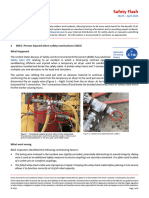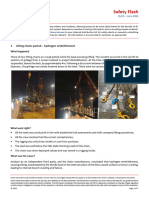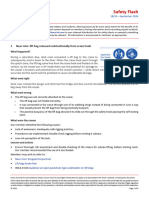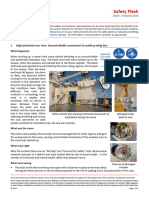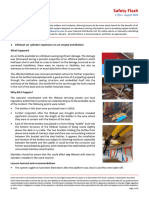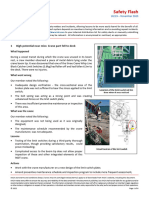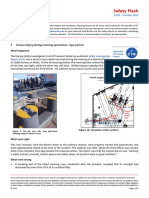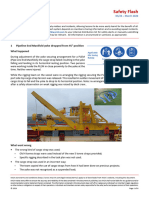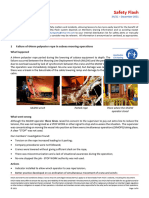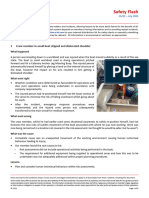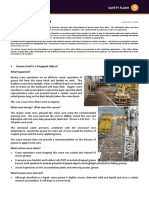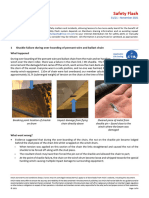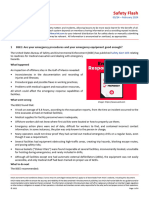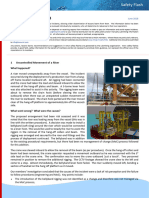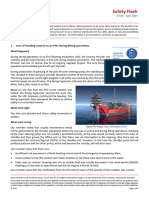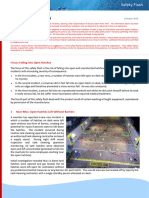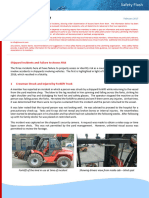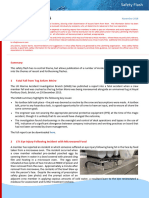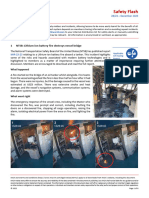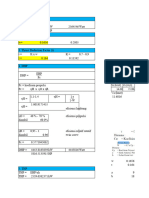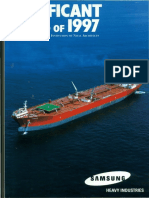SF 12 23
SF 12 23
Uploaded by
Shivkumar JadhavCopyright:
Available Formats
SF 12 23
SF 12 23
Uploaded by
Shivkumar JadhavOriginal Description:
Original Title
Copyright
Available Formats
Share this document
Did you find this document useful?
Is this content inappropriate?
Copyright:
Available Formats
SF 12 23
SF 12 23
Uploaded by
Shivkumar JadhavCopyright:
Available Formats
Safety Flash
12/23 – May 2023
IMCA Safety Flashes summarise key safety matters and incidents, allowing lessons to be more easily learnt for the benefit of all.
The effectiveness of the IMCA Safety Flash system depends on members sharing information and so avoiding repeat incidents.
Please consider adding safetyreports@imca-int.com to your internal distribution list for safety alerts or manually submitting
information on incidents you consider may be relevant. All information is anonymised or sanitised, as appropriate.
1 Differential pressure: dummy choke ejected close to divers
What happened?
Applicable 0
Life Saving
A dummy choke insert was ejected from a water injection (WI) tree by force of differential
Rule(s)
pressure, while divers were working nearby. A Dive team was removing a dummy choke Energy
insert and replacing it with a choke valve insert. The WI tree had been subject to hydrate Isolation
remediation works. With no hydrates evident, limited trapped or pressurised gas was expected and tested barriers
and isolations were in place. During the removal of the half shell clamps that retained the dummy choke insert,
unexpected differential pressure from the flowline forced the dummy choke insert (85kg in water) out of the choke
valve body at significant force. The two divers were loosening the clamp bolts around the dummy choke and were
therefore close by when it ejected. Neither diver was in the direct line of fire; both were unharmed.
What went wrong
• During the design of the dummy choke insert, the decision was made not to include a test port, which would
have allowed venting of any pressure built up in the flowline. The port was not part of the supplier’s standard
design, and there was not enough time to approve a design change to include the port;
• The project procedure instructed that the Subsea Pressure and Monitoring Manifold (SPAMM) should be left
closed, so there was no local vent path from the flowline;
• When pressure differentials in the system were noted prior to the dummy choke removal, there was no
recognition that readings were not as expected, and no discussions within the team relating to venting off the
remaining pressure;
• Based on previous experience at the tree, gas/fluid release had been identified as a hazard in the procedure
and in the HIRA (Hazard Identification and Risk Assessment), however no parameters had been set as to the
expected volume or duration of the release;
• Divers continued to work to loosen the clamp while gas/fluid was escaping from the choke, as the team had
assumed that previous venting had been successful, and that they were safe to proceed;
• Our member notes that “the key point throughout was the failure to understand the exact pressure within the
flowline, which was the residual 2 bar head of pressure from the riser after Floating Production Storage and
Offloading (FPSO) venting”.
IMCA store terms and conditions (https://www.imca-int.com/legal-notices/terms/) apply to all downloads from IMCA’s website, including this document.
IMCA makes every effort to ensure the accuracy and reliability of the data contained in the documents it publishes, but IMCA shall not be liable for any guidance and/or
recommendation and/or statement herein contained. The information contained in this document does not fulfil or replace any individual’s or Member's legal, regulatory
or other duties or obligations in respect of their operations. Individuals and Members remain solely responsible for the safe, lawful and proper conduct of their operations.
© 2022 Page 1 of 7
Actions suggested
• Design safety in at the early engineering phase of a project – in this case, inclusion of a test port;
• Ensure procedures and risk assessments are clear, unambiguous, and explicit in their requirements (rather than
leaving things vague, ambiguous and implicit). This is particularly important when dealing with a pressurised
system and/or with stored energy;
• When using subsea pressure gauges, ensure any reading anomalies are well understood, communicated to the
full team, and recorded. If the gauge is behaving in an anomalous way, swap it out;
• When ‘line of fire’ or ‘stored energy’ is identified as a
hazard, ensure that control measures are specific in how
these hazards will be managed so that personnel are in a
safe position. Relevant control measures may include:
hard barriers, safe havens, extended hand tools or use of
rigging;
• When carrying out diver intervention works involving
barriers and isolations, ensure all relevant parties have
had comprehensive training in isolations and barriers;
• Divers and Dive Supervisors should confirm a local vent is
open before starting any work on pressurised systems;
• If any step in a procedure doesn’t look right (e.g., local
vent to be left closed when working on a pressurised
system), STOP the JOB: Call an all stop and seek clarification.
Members may wish to refer to (focus here on differential pressure):
• Near miss: Unidentified differential pressure led to diver’s umbilical getting trapped
• Fatal diver incident due to uncontrolled differential pressure
• Identification of differential pressures subsea during diving operations
2 Crane boom stopper fell to main deck
What happened
A knuckle boom stopper pad fell to the main deck directly below the knuckle boom. No personnel were injured,
however there was potential for serious or fatal injury. The incident occurred when a crane operator started moving
the crane boom in prepration for use. Once the crane was clear of all obstructions the crane operator started
slewing it outboard. The rigging supervisor acting as banksman was in attendance, located on the inboard dedicated
walkway. As the crane boom was slewing, the crane operator saw the boom stopper sliding down the knuckle boom
and then falling to the deck. The crane operator immediately sounded the crane horn. The boom stopper weighed
15.5kg and fell 35m. There were no personnel near where it dropped/landed.
Investigation
• The area where the knuckle boom stopper pad landed was not a restricted area, access up and down the deck
was via a dedicated walkway, inboard of the boom, 5m away from where the boom stopper landed;
• The knuckle boom stopper pad was only attached to the backing plate by adhesive and then the backing plate
bolted to the boom stopper frame structure.
Actions taken
• Vessel technicians modified the backing plate by securing the boom stopper pad with 8 x M16 countersunk cap
screws, Loctite and centre dab, and then it was reinstalled by a rope access team. The metal backing plate was
IMCA Safety Flash 12/23 Page 2 of 7
secured with M20 bolts using nyloc and Loctite, preventing any repeat of the boom stopper becoming
detached.
• There is potential for similar incidents to happen on other vessels, in areas where access to potential dropped
objects is difficult. Check and see:
̶ If any other cranes use the same or similar type pads and if so, ensure alternative or additional fixings are
applied to any connections solely reliant on adhesive compound bonding;
IMCA Safety Flash 12/23 Page 3 of 7
̶ Identify equipment and structures that present a risk of dropped objects and cannot be easily accessed for
inspection and determine the best means of safe access and an appropriate frequency of inspection;
̶ Verify if there is an existing work order or dropped object check list to cover these items and add/update
as necessary.
Members may wish to refer to:
• Dropped object near miss – crane boom bumper stop falls off
• Crane boom dropped object
• Dropped Object – Crane auxiliary block dropped from crane boom
• Dropped object: Signage dropped from crane boom
• Near-miss: Dropped object fell from crane boom
3 Fire alarm activation in engine room
What happened
Applicable
There was a small fire in a vessel engine room. There was little damage and no-one was Life Saving
harmed. The incident occurred while a supply vessel was operating within the 500m Safety Rule(s) Bypassing
Zone of an offshore platform. An alarm appeared on the vessel’s fire alarm control panel, Safety
Controls
indicating a fire in the starboard side Engine Room cement compartment. Engineers
investigated, observed white smoke and reported this to the Bridge. The Master decided to take the vessel out of
the 500m zone, changed propulsion control mode to manual and then shut down the starboard main engine. The
crew proceeded to muster stations. After consulting with the Master and confirming that all personnel were
mustered, the fixed CO2 system was activated by the Chief Engineer. The vessel returned to port for further
investigation and repairs.
Smoke detector over the affected Shaft Generator Rotor of Shaft generator/ failed bearing part caused
overheating and smoke
What went wrong
• The temperature sensor installed in the Starboard Shaft Generator was providing inconsistent readings since
the most recent overhaul; this had not been reported by the engine crew;
• Our member highlighted two particular concerns:
IMCA Safety Flash 12/23 Page 4 of 7
̶ The firefighting CO2 suppression system remote activation failed. Further investigation revealed there was
an issue with an empty pilot cylinder, potentially due to leakage in the piping between pilot and CO2
cylinders.
̶ Crew released CO2 system while trying to tackle the fire in cement compartment. However, the cement
compartment appeared not to have a CO2 discharge point, as per vessel design, and this was not reflected
in the vessel fire training manual.
What was the cause
The smoke was caused by a failed diesel generator bearing. After disassembling the starboard shaft generator it
was observed that grease in the bearing had overheated; this had generated dense white smoke.
Lessons
• Ensure crew regularly practice their knowledge on fire emergency including the activation of the fixed CO2 fire
suppression system;
• Ensure crew are familiar with the vessel fire training manual and fire response system design;
• Review the vessel fire manual to ensure it provides an accurate overview of the vessel’s firefighting equipment
functionality and relevant limitations. Any discrepancies should be reported and addressed as a priority.
Members may wish to refer to:
• Alternator bearing collapse caused small fire
• Fire in the engine room
• Incidents and events relating to C02 systems
4 BSEE: Swing rope transfers
The United States Bureau of Safety and Environmental Enforcement (BSEE) has published Safety Alert 456 relating
to the dangers inherent to swing rope transfers. The BSEE notes that “personnel transfers using swing ropes and
baskets present a considerable risk for offshore workers.” The use of swing ropes is not permitted in some parts of
the world.
This is passed on as of interest to members, while noting clearly that IMCA does not recommend the use of swing
ropes. (Section 4.4.4, Guidance on the transfer of personnel to and from offshore vessels and structures).
What happened
A recent example of an injury incurred during a swing rope transfer, is a fractured foot sustained by a worker
attempting to use a swing rope to board a satellite platform from a
work boat. As the Captain manoeuvered the boat, the worker
placed his foot on a bumper tire to position himself for the swing.
The worker’s foot slipped between the tyre and the boat when the
tyre hit the platform, resulting in injury.
BSEE notes two further injuries in the last five years:
• An employee lacerated his shin after it struck the rear of a
vessel as he was completing a swing;
• An employee fell into the water between a workboat and a
platform when he misjudged the distance between the boat’s
deck and the top of a swell during a swing rope transfer. As he made his swing, the wave shifted the boat,
moving the landing area. When the employee let go of the swing rope, he fell into the water. He was quickly
retrieved from the water and did not sustain injuries.
BSEE recommends that:
IMCA Safety Flash 12/23 Page 5 of 7
• All offshore personnel transfers are treated as stand-alone operations;
• Formal risk assessment is conducted before a transfer occurs;
• There is “Stop work authority” for all persons involved.
Because of the inherent risks involved, BSEE also recommends that alternative methods are used where practicable
and that there is routine assessment of the training and competence of everyone who has responsibilities for, and
is involved with, personnel transfer.
As noted above, IMCA does not recommend the use of swing ropes.
Members should refer to IMCA HSSE 025 Guidance on the transfer of personnel to and from offshore vessels and
structures.
5 Close approach of AHTS vessel to offshore rig
What happened
Applicable
An AHTS vessel made a close approach to the mooring lines for an offshore rig. The AHTS Life Saving
was involved in anchor handling operations for the rig. The vessel passed anchor line #6 Rule(s) Bypassing
to the rig and started to move towards anchor line #3. Control of the vessel was Safety
Controls
transferred from forward to aft console. Once in position, the vessel received the PCP
(Permanent Chasing Pennant) of anchor line #3 by rig crane and it was secured on the Karm fork. The rig’s crane
was released, but the chaser’s collar slid on the anchor line towards anchor #3 and pulled the stern of the vessel to
starboard, resulting in a bow side close approach to mooring line #2.
To stop this movement the Master activated the bow tunnel thruster, but the thruster did not start. As a result,
the vessel bow had a close approach to mooring line #2. The Master immediately switched on all thrusters, obtained
full manoeuvrability of the vessel, and the vessel pulled away safely.
A line drawing showing the AHTS vessel’s movement
from anchor line #6 to anchor line #3
What was the cause?
• Further review identified that the bow thruster electromotor was off. Machinery required for safe manoeuvring
of the vessel had been disabled. The electromotors for the tunnel thrusters had been switched off by the chief
officer to rest the machinery as the vessel was leaving the 500m zone. This fact had not been communicated to
the Master;
IMCA Safety Flash 12/23 Page 6 of 7
• The fact that the servo pumps were running gave a false assurance of full operability of the thrusters;
• There was no check of full operability after transfer of vessel control from forward to aft control stations.
Actions taken
• Ensured that critical vessel equipment is not switched off or its operational mode changed without the approval
of the person in charge on the bridge;
• Manual transfer of vessel control to be followed by mandatory thorough checks of all propulsion relevant to
the operation;
• Developed comprehensive work instructions for bridge transfer control.
Members may wish to refer to:
• Vessel activities near platforms – two incidents
• Near miss: vessel approach to wind turbine tower
• MSF: Contact between Vessel and Offshore Installation
IMCA Safety Flash 12/23 Page 7 of 7
You might also like
- IMCAD078 Guidance On Diving Umbilical ManagementDocument79 pagesIMCAD078 Guidance On Diving Umbilical Managementherve.rozecNo ratings yet
- SF 22 24Document7 pagesSF 22 24신영호No ratings yet
- SF 10 23Document6 pagesSF 10 23Gusman TriadyNo ratings yet
- SF 15 23Document7 pagesSF 15 23Shivkumar JadhavNo ratings yet
- SF 18 24Document6 pagesSF 18 24yip.k.andiNo ratings yet
- SF 04 23Document6 pagesSF 04 23Reda MashalNo ratings yet
- SF 25 23Document8 pagesSF 25 23loai allamNo ratings yet
- SF 29 23Document6 pagesSF 29 23Shivkumar JadhavNo ratings yet
- SF 17 24Document6 pagesSF 17 24yip.k.andiNo ratings yet
- SF 26 23Document6 pagesSF 26 23Shivkumar JadhavNo ratings yet
- SF 17 22Document5 pagesSF 17 22Shivkumar JadhavNo ratings yet
- SF 02 24Document6 pagesSF 02 24Shivkumar JadhavNo ratings yet
- SF 23 22Document6 pagesSF 23 22Shivkumar JadhavNo ratings yet
- SF 05 24Document6 pagesSF 05 24aadamekNo ratings yet
- SF 06 24Document6 pagesSF 06 24Shivkumar JadhavNo ratings yet
- SF 22 23Document6 pagesSF 22 23Shivkumar JadhavNo ratings yet
- SF 24 23Document5 pagesSF 24 23Shivkumar JadhavNo ratings yet
- SF 06 22Document5 pagesSF 06 22Shivkumar JadhavNo ratings yet
- SF 10 24Document7 pagesSF 10 24Shivkumar JadhavNo ratings yet
- SF 23 23Document5 pagesSF 23 23Shivkumar JadhavNo ratings yet
- SF-34-21-January 2021Document6 pagesSF-34-21-January 2021Shivkumar JadhavNo ratings yet
- SF 16 23Document6 pagesSF 16 23Shivkumar JadhavNo ratings yet
- SF 18 23Document6 pagesSF 18 23Shahriyar ShahNo ratings yet
- SF34 20Document7 pagesSF34 20Hal GhentNo ratings yet
- Imcasf 22 19Document5 pagesImcasf 22 19Pippo TopolinoNo ratings yet
- IMCASF - Oct 20Document6 pagesIMCASF - Oct 20Shivkumar JadhavNo ratings yet
- IMCA Safety Flash 21-24 - October 2024Document5 pagesIMCA Safety Flash 21-24 - October 2024be.inspectioncoordinatorNo ratings yet
- SF 17 22Document6 pagesSF 17 22Shivkumar JadhavNo ratings yet
- SF 16 22Document6 pagesSF 16 22Shivkumar JadhavNo ratings yet
- SF 01 24Document7 pagesSF 01 24Shahriyar ShahNo ratings yet
- SF 11 23Document6 pagesSF 11 23Shivkumar JadhavNo ratings yet
- IMCASF - Sept 20Document6 pagesIMCASF - Sept 20Shivkumar JadhavNo ratings yet
- Imcasf 31 21Document6 pagesImcasf 31 21Paulo IsabelNo ratings yet
- SF 11 24Document7 pagesSF 11 24Ahmed AshourNo ratings yet
- SF 05 22Document5 pagesSF 05 22Shivkumar JadhavNo ratings yet
- SF 28 22Document5 pagesSF 28 22Shivkumar JadhavNo ratings yet
- IMCASF - Aug 17Document7 pagesIMCASF - Aug 17Shivkumar JadhavNo ratings yet
- IMCASF - Oct 18Document5 pagesIMCASF - Oct 18Shivkumar JadhavNo ratings yet
- SF 03 24sssDocument6 pagesSF 03 24sssShahriyar ShahNo ratings yet
- IMCASF - Jan 18Document5 pagesIMCASF - Jan 18Shivkumar JadhavNo ratings yet
- SF 08 22Document6 pagesSF 08 22Shivkumar JadhavNo ratings yet
- SF 08 24Document6 pagesSF 08 24Shivkumar JadhavNo ratings yet
- IMCASF - Feb 19Document6 pagesIMCASF - Feb 19Shivkumar JadhavNo ratings yet
- IMCASF - Oct 17Document6 pagesIMCASF - Oct 17Shivkumar JadhavNo ratings yet
- IMCASF - Jun 17Document5 pagesIMCASF - Jun 17Shivkumar JadhavNo ratings yet
- Crush Injury during Lifting OperationsDocument12 pagesCrush Injury during Lifting OperationsMohamed DabyNo ratings yet
- SF 19 22Document6 pagesSF 19 22Shivkumar JadhavNo ratings yet
- IMCASF - Dec 17Document6 pagesIMCASF - Dec 17Shivkumar JadhavNo ratings yet
- IMCASF - Jun 18Document5 pagesIMCASF - Jun 18Shivkumar JadhavNo ratings yet
- IMCASF - Feb 16Document6 pagesIMCASF - Feb 16Shivkumar JadhavNo ratings yet
- IMCASF - May 20Document6 pagesIMCASF - May 20Shivkumar JadhavNo ratings yet
- Differential PressureDocument3 pagesDifferential Pressurethanhbem301No ratings yet
- IMCASF - Nov 16Document7 pagesIMCASF - Nov 16Shivkumar JadhavNo ratings yet
- IMCASF - Aug 19Document6 pagesIMCASF - Aug 19Shivkumar JadhavNo ratings yet
- Improper Slinging of CargoDocument6 pagesImproper Slinging of CargoMohamed DabyNo ratings yet
- SF 07 24Document6 pagesSF 07 24Shivkumar JadhavNo ratings yet
- Diver exposed to unplanned release of production gasDocument2 pagesDiver exposed to unplanned release of production gasprasanthreddy danduNo ratings yet
- IMCA Safety Flashes 2009 07Document6 pagesIMCA Safety Flashes 2009 07Francisco TajúNo ratings yet
- IMCASF - Nov 18Document5 pagesIMCASF - Nov 18Shivkumar JadhavNo ratings yet
- SF 27 22Document5 pagesSF 27 22Shivkumar JadhavNo ratings yet
- IMCASF - Jun 17Document6 pagesIMCASF - Jun 17Shivkumar JadhavNo ratings yet
- IMCASF - Oct 18Document5 pagesIMCASF - Oct 18Shivkumar JadhavNo ratings yet
- IMCASF - Mar 18Document3 pagesIMCASF - Mar 18Shivkumar JadhavNo ratings yet
- IMCASF - Mar 17Document6 pagesIMCASF - Mar 17Shivkumar JadhavNo ratings yet
- IMCASF - Jul 18Document6 pagesIMCASF - Jul 18Shivkumar JadhavNo ratings yet
- IMCASF - May 17Document7 pagesIMCASF - May 17Shivkumar JadhavNo ratings yet
- IMCASF - Mar 17Document5 pagesIMCASF - Mar 17Shivkumar JadhavNo ratings yet
- IMCASF - Jul 17Document6 pagesIMCASF - Jul 17Shivkumar JadhavNo ratings yet
- IMCASF - Jun 17Document5 pagesIMCASF - Jun 17Shivkumar JadhavNo ratings yet
- IMCASF - Mar 18Document4 pagesIMCASF - Mar 18Shivkumar JadhavNo ratings yet
- IMCASF - Feb 17Document3 pagesIMCASF - Feb 17Shivkumar JadhavNo ratings yet
- IMCASF - Jan 17Document2 pagesIMCASF - Jan 17Shivkumar JadhavNo ratings yet
- IMCASF - Oct 16Document4 pagesIMCASF - Oct 16Shivkumar JadhavNo ratings yet
- IMCASF - Jan 17Document7 pagesIMCASF - Jan 17Shivkumar JadhavNo ratings yet
- IMCASF - Feb 17Document4 pagesIMCASF - Feb 17Shivkumar JadhavNo ratings yet
- IMCASF - Oct 16Document6 pagesIMCASF - Oct 16Shivkumar JadhavNo ratings yet
- IMCASF - Nov 16Document4 pagesIMCASF - Nov 16Shivkumar JadhavNo ratings yet
- IMCASF - Aug 16Document10 pagesIMCASF - Aug 16Shivkumar JadhavNo ratings yet
- IMCASF - Nov 16Document4 pagesIMCASF - Nov 16Shivkumar JadhavNo ratings yet
- IMCASF - May 20Document3 pagesIMCASF - May 20Shivkumar JadhavNo ratings yet
- IMCASF - Apr 16Document3 pagesIMCASF - Apr 16Shivkumar JadhavNo ratings yet
- IMCASF - Oct 16Document2 pagesIMCASF - Oct 16Shivkumar JadhavNo ratings yet
- IMCASF - Apr 16Document6 pagesIMCASF - Apr 16Shivkumar JadhavNo ratings yet
- SF 27 23Document6 pagesSF 27 23Shivkumar JadhavNo ratings yet
- IMCASF - May 20Document6 pagesIMCASF - May 20Shivkumar JadhavNo ratings yet
- SF 02 24Document6 pagesSF 02 24Shivkumar JadhavNo ratings yet
- SF 04 24Document6 pagesSF 04 24Shivkumar JadhavNo ratings yet
- SF 07 24Document6 pagesSF 07 24Shivkumar JadhavNo ratings yet
- SF 22 23Document6 pagesSF 22 23Shivkumar JadhavNo ratings yet
- SF 28 23Document8 pagesSF 28 23Shivkumar JadhavNo ratings yet
- So-0609E5 Polaris Technical Manual Section 2 Technical DatDocument138 pagesSo-0609E5 Polaris Technical Manual Section 2 Technical DatFernando CresteloNo ratings yet
- DNVGL RU SHIP Pt6Ch4Document150 pagesDNVGL RU SHIP Pt6Ch4orlinski32No ratings yet
- Side Power Thruster SE170 - 250TC IP Ignition ProtectedDocument20 pagesSide Power Thruster SE170 - 250TC IP Ignition ProtectedkloostNo ratings yet
- CastoroneDocument2 pagesCastoroneKanimolie SegaranNo ratings yet
- Comet 5.0 Fiksasi Revisi AkhirDocument198 pagesComet 5.0 Fiksasi Revisi AkhirKhansa ArkhapNo ratings yet
- Thruster 140-300TT - B500100 Iss 6Document28 pagesThruster 140-300TT - B500100 Iss 6Heriberto TorresNo ratings yet
- A Master's Guide To Berthing 2nd EditionDocument40 pagesA Master's Guide To Berthing 2nd EditionGee VilladarezNo ratings yet
- PMS BrochureDocument6 pagesPMS BrochureOsama KashkoushaNo ratings yet
- NAV107 DP2 FMEA Rev 1 76630408Document96 pagesNAV107 DP2 FMEA Rev 1 76630408Luiz Eugênio dos Reis GomesNo ratings yet
- SEAM 111 Ship Parts and Their FunctionsDocument54 pagesSEAM 111 Ship Parts and Their FunctionsDeku GamingNo ratings yet
- Significant Ships 1997Document103 pagesSignificant Ships 1997Marcel SchmalNo ratings yet
- Brochure Veth Propulsion - Bow Thrusters ENGDocument36 pagesBrochure Veth Propulsion - Bow Thrusters ENGfwfchmielewskiNo ratings yet
- Twindisc ProductsDocument59 pagesTwindisc ProductsJorge SoberanoNo ratings yet
- Tunnel ThrusterDocument4 pagesTunnel ThrustermohammadfarsiinfoNo ratings yet
- CMC - Hydraulic Bow and Stern Thruster (Dualis Hydro BTM50) USER MANUALDocument43 pagesCMC - Hydraulic Bow and Stern Thruster (Dualis Hydro BTM50) USER MANUALjomarcleofeNo ratings yet
- IMCA - DignityDownload-5353 (IMCA DP Event Reporting Form)Document6 pagesIMCA - DignityDownload-5353 (IMCA DP Event Reporting Form)Vladimir MustafayevNo ratings yet
- Semi Submersible Heavy Lift VesselDocument12 pagesSemi Submersible Heavy Lift VesselmailokeNo ratings yet
- 2014 Paper Berth Scour Protection For Modern VesselsDocument20 pages2014 Paper Berth Scour Protection For Modern VesselsFelipe Strafite CusterNo ratings yet
- ASD Tug ManoeuvringDocument22 pagesASD Tug ManoeuvringJonerick CaceresNo ratings yet
- Mustafa Pasaoglu 2015 Assessment of The Applicability of The PIANC Guidelines On Protecting Berthing Structures From Scour Caused by ShipsDocument112 pagesMustafa Pasaoglu 2015 Assessment of The Applicability of The PIANC Guidelines On Protecting Berthing Structures From Scour Caused by ShipsAl-Razzaq Al-WahhabNo ratings yet
- Bow Thruster, Ship Stabilizer MGPSDocument13 pagesBow Thruster, Ship Stabilizer MGPSSayem kaifNo ratings yet
- QL Parts ListDocument32 pagesQL Parts Listmahshook666No ratings yet
- Dynamic Positioning c11Document60 pagesDynamic Positioning c11S DNo ratings yet
- Bottom Complete SurveyDocument3 pagesBottom Complete Surveyahmed shreifNo ratings yet
- 4 ImtraDocument72 pages4 ImtraPengjing WangNo ratings yet
- SO-1543-A1 Kongsberg Challenger II - DP Vessel Reference DocumentationDocument22 pagesSO-1543-A1 Kongsberg Challenger II - DP Vessel Reference DocumentationJurcyś StalloneNo ratings yet
- KPV RedangDocument4 pagesKPV Redangmohd lopezNo ratings yet
- Voltaire Wind Turbine Installation Vessel 18027Document1 pageVoltaire Wind Turbine Installation Vessel 18027Mario RossiNo ratings yet
- ZF HRP Tunnel Thruster HRP 4001 ManuelDocument35 pagesZF HRP Tunnel Thruster HRP 4001 ManuelSelim Kazan100% (1)


